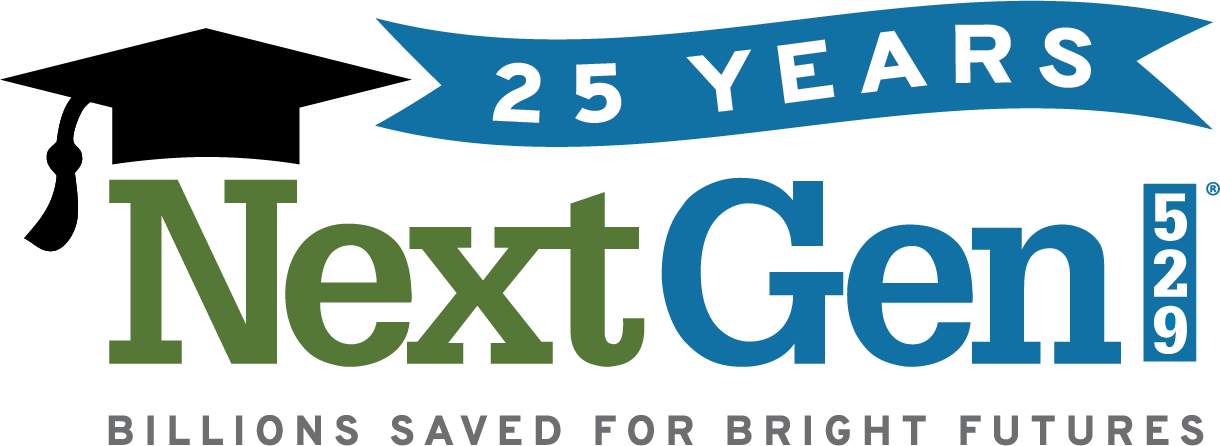HAVE A QUESTION?
FAQs
Have a question? Get answers to frequently asked questions about NextGen 529 plans. Don’t see your question? Contact Customer Service.
About NextGen 529
What is NextGen 529?
NextGen 529 is Maine’s Section 529 plan. A 529 plan is an investment plan primarily designed to help families save for higher education. They’re called 529 plans because they’re described in Section 529 of the U.S. Internal Revenue Code.
Any earnings in a NextGen 529 account can grow tax-free. Withdrawals, including any earnings, are federal tax-free when withdrawn to pay for qualified higher education expenses.1
What can I use the money I save in a Nextgen 529 account for? What’s a qualified expense?
You can use your NextGen 529 account funds to pay for a variety of qualified education expenses1 at eligible higher education institutions, which include four-year colleges or universities, accredited two-year associate degree programs, vocational schools, trade schools, even qualified online courses– any post-secondary schools that participate in federal financial aid programs—at home or abroad. Qualified education expenses generally include expenses such as tuition and fees, computers, books and supplies, and room and board (for students who attend school at least half time).
In addition, NextGen 529 account funds can be used to pay for fees, books, supplies, and equipment required for the participation of a beneficiary in an apprenticeship program registered and certified with the Secretary of Labor under the National Apprenticeship Act. A maximum of $10,000 can be withdrawn to pay for principal or interest on qualified student loans of the designated beneficiary or a sibling of the beneficiary.
You can also use up to $10,000 per year for the same beneficiary to pay for K-12 tuition at an eligible elementary or secondary school. While Maine considers K-12 expenses a qualified expense for state tax purposes, other states may treat withdrawals from a 529 for K-12 expenses differently.
What if my child doesn’t go to college?
If your child doesn’t choose to go to college (and remember, college includes trade and vocational school, two-year programs, even qualified online courses), you have some choices. You could:
- Leave it invested! The money you invested can stay in the account. It can still have the opportunity to grow tax-deferred until your child decides to attend college in the future. There is currently no time limit on when funds must be withdrawn.
- Transfer the savings to another eligible family member,2 such as a sibling or even yourself–you could use it for your own higher education!
- Starting in 2024, account owners can add unused funds from a 529 account to a Roth IRA for the benefit of their student, subject to certain limitations. Learn more.
- Withdraw the money and use it however you like. You will need to pay taxes on any earnings, plus a 10% penalty on those earnings. The penalty doesn’t apply if:
- The beneficiary receives a scholarship. You can withdraw up to the amount of the scholarship from your account.
- The beneficiary becomes disabled.
- The beneficiary dies and the withdrawal is paid to the beneficiary’s estate.
Also, even if your child gets a scholarship and doesn’t need the money for tuition, you may still have expenses to pay, such as fees, computers, books and supplies, and room and board (for students attending at least half time).
Opening a NextGen 529 account
Who can open a NextGen 529 account? Does it have to be a parent?
You don’t have to be the parent or even related to the student. Parents, grandparents and even family friends can open an account, no matter the income or age of the student. You also can open an account to invest for your own future higher education expenses.
Account owners must reside in the United States and be 18 or older, with a valid Social Security number (without work restrictions) or U.S. taxpayer identification number. Noncitizens need to document their United States residency by providing a copy of their United States Permanent Resident Card (commonly known as a “Green Card”) and passport.
Who is the account owner and who is the beneficiary?
The account owner, also called the participant, is the person who opens and retains control of the account. NextGen 529 accounts can only be owned by one person. The account owner is often a parent, but accounts can also be owned by grandparents, other family members, and even family friends. An adult can also own an account for themselves. The account owner controls the account, opens the account in their name and address, and receives all communications associated with the account to help them decide how the money is invested and for what the money is withdrawn.
The designated beneficiary is the person benefiting from the NextGen 529 account. The beneficiary is often a child, but it can also be an adult student saving for a return to school or further training. (In this case, the account owner and the beneficiary can be the same person.)
If the account owner wishes to share a duplicate account statement with another person, they can request a duplicate by contacting the account servicer.
Can my child access funds in the account?
No. As the account owner of an individual NextGen 529 account, you retain control of the account. Only you can instruct how and when withdrawals are made from the account.
Can funds be transferred into a NextGen 529 account from a Coverdell Education Savings Account (Coverdell ESA) or another state’s 529 plan?
Yes. Currently, you are permitted one rollover per 12-month period from a Coverdell ESA or other Section 529 plan for the same designated beneficiary.
Benefits for Maine Residents
Is there a Maine State Tax Deduction?
Maine offers a $1,000 Maine income tax deduction on contributions made to NextGen 529 (and any other 529 plan). Tax filers can claim this deduction if their federal adjusted gross income is $100,000 or less if filing single or married filing separately, or $200,000 or less if filing as head of household or married filing jointly. Go to Maine State Tax Deduction to learn more.
What are the Grants for Maine Residents?
Maine residents can receive grant money when they open a NextGen 529 account, make contributions, and set up automated funding. In addition, all babies born Maine residents receive the $500 Alfond Grant for higher education expenses. To learn the specifics about each grant, go to Grants for Maine Residents.
What is the Maine Administration Fee Rebate Program?
If either the NextGen 529 account owner or the account beneficiary is a Maine resident, an amount approximately equal to any Maine Administration Fee paid during the year will be automatically rebated to eligible accounts in the following year. To qualify, on the last business day of the calendar year the account must have a balance of at least $1,000 and must be invested in a Portfolio subject to the Maine Administration Fee. The minimum rebated amount is $2.00; amounts less than $2.00 will not be paid.
Tax Benefits
What are the tax benefits of NextGen 529 and other 529 plans?
Tax-free growth
Any earnings can grow free from federal and Maine state income tax. Withdrawals, including any earnings, are tax-free when withdrawn to pay for qualified higher education expenses.1 These tax benefits can help maximize your contributions to your 529 account.
Maine state tax deduction
Maine offers a $1,000 Maine income tax deduction on contributions made to NextGen 529 (and any other 529 plan). Tax filers can claim this deduction if their federal adjusted gross income is $100,000 or less if filing single or married filing separately, or $200,000 or less if filing as head of household or married filing jointly.
Other states offer tax deductions. Learn more at finaid.org:
Gift tax benefits
529 plans also offer federal estate and gift tax benefits, making them a valuable estate-planning tool.
A contribution to a 529 plan account is treated as a completed gift from the giver to the recipient (the designated beneficiary of the 529 account) and qualifies for the annual federal gift tax exclusion of $18,000 ($36,000 for married couples filing jointly), per beneficiary. This allows you to remove assets from your taxable estate while contributing to an account that you control, if you are the account owner.
You may also be able to take advantage of a federal gift tax election that applies only to 529 plan contributions. This allows you to make a lump-sum contribution of up to $90,000 ($180,000 for married couples filing jointly), which is five times the annual exclusion amount, per beneficiary in one year, and treats the contribution as if it was made ratably over five years.3
Managing Your NextGen 529 Account
How do I contribute to my NextGen 529 account?
Contributions can be made online, by check, or by transferring or rolling over funds from another account. You can make it easy by setting up automatic contributions from your checking or savings account, or using payroll deduction.
Learn more about making contributions to your Connect Account
Learn more about making contributions to your Direct Account
Your financial advisor can help you with contributions to your Select Account.
Can I contribute to both a Coverdell Education Savings Account (Coverdell ESA or Education IRA) and a 529 plan such as NextGen 529 in the same year?
Yes. Currently you can contribute to both a Section 529 account and a Coverdell ESA in the same year for the same beneficiary. If you are using the gift tax exclusion, the limit applies to contributions to both types of accounts.
What are the minimum and maximum account contributions?
There is no minimum contribution amount after you open your account with $25. Make contributions when you can, in whatever amount you are able.
Also, if your child received the $500 Alfond Grant, no initial contribution is necessary.
NextGen 529’s maximum contribution limit is generous – $545,000 across all 529 accounts for the same beneficiary.
How is my money invested?
NextGen 529 is offered through three series—check out the options available for Connect, Direct, and Select Accounts!
Connect Accounts
A Connect Account offers a Year of Enrollment investment option. When you open your Connect Account you will be asked to enter the age your beneficiary will start using their funds. Based on the expected age entered, you will be presented with the Year of Enrollment Portfolio that best corresponds to the year in which you expect the beneficiary to start using their funds. After your account is opened, you can change your investment option to another portfolio or to the NextGen Savings Portfolio—a stable principal option, eligible for FDIC insurance. Learn more about Connect Account investment options.
Direct Accounts
When you open a NextGen 529 Direct Account, you’ll be able to choose from 33 investment options, including two suites of Year of Enrollment Portfolios, Diversified Portfolios, Single Fund Portfolios, and two stable principal portfolios. With a Direct Account you can build a college savings plan that works to suit your family’s savings goals. Learn more about Direct Account investment options.
Select Accounts
Select Accounts are for people who work with a financial advisor. There are 80 investment options, including 78 investment options managed by one of BlackRock, Franklin Templeton, Lord Abbett, NYLI, MFS or Neuberger Berman, as well as the Principal Plus Portfolio and the NextGen Savings Portfolio. These investments are sold through financial advisors. Learn more about Select Account investment options.
Using Your NextGen 529 Account
How do I make a withdrawal from my NextGen 529 account?
There are a number of ways to make a withdrawal–you can request a check, transfer funds to your bank account, or even send funds directly to a school. Your financial advisor can help you with a withdrawal from your Select Account.
Learn more about making withdrawals from your Direct Account
Learn more about making withdrawals from your Connect Account
How do assets in a 529 account impact financial aid for college?
A family’s income (not savings or assets) is the primary factor in determining federal financial aid eligibility. The federal financial aid eligibility formula includes an Education Savings and Asset Protection Allowance that excludes a portion of the assets that are counted (primary residence and retirement accounts are already excluded). Only “countable” assets (including 529 plan assets) that exceed the allowance have ANY impact – and currently not more than 5.64%.4 For some families, college savings won’t reduce financial aid at all.
Any savings that a student uses to pay for college are helpful because they can reduce reliance on loans, which must be repaid with interest.
NextGen 529 and Other Saving Plans
Can I transfer funds from a Uniform Gift/Transfer to Minors Account (UGMA/UTMA) custodial account into a NextGen 529 account?
Yes. But, because securities cannot be contributed to a 529 account, you must first liquidate any securities in the UGMA/UTMA account in order to invest the cash into your NextGen 529 account. You’ll need to open a custodial NextGen 529 account to receive UGMA/UTMA funds.
In addition, you will have to report any gains/losses incurred from liquidating the custodial accounts on your personal tax return. You should discuss any financial transactions with your professional tax advisor.
The good news is that, once the custodial assets are deposited into a NextGen 529 account, you have the opportunity to benefit from the advantages of NextGen 529 and eliminate any need to file an annual tax return for the UGMA/UTMA assets held in the NextGen 529 account.
Can I roll over funds from a NextGen 529 account to an ABLE account?
Yes. Effective December 22, 2017, you may roll over amounts in a 529 plan account to a Section 529A Qualified ABLE Program (ABLE) account for the same designated beneficiary, or a qualified family member of the beneficiary, federal income tax free, subject to applicable ABLE contribution limits. Distributions in connection with ABLE rollovers must occur before January 1, 2026. Tax treatment of ABLE rollovers may differ in some states. Please consult your tax advisor for specific advice regarding such distributions.
Please note that Maine’s ABLE program, ABLE ME, can only accept rollovers without earnings from another State’s 529A Qualified ABLE Program or 529 Qualified Tuition Program. For more information, visit ABLE Maine | Office of the Maine State Treasurer.


1To be eligible for favorable tax treatment afforded to any earnings portion of withdrawals from Section 529 accounts, such withdrawals must be used for qualified higher education expenses, as defined in Section 529 of the Internal Revenue Code. Any earnings withdrawn that are not used for qualified higher education expenses are subject to federal income tax and may be subject to a 10% additional federal tax, as well as to state and local income taxes. State tax treatment of distributions for certain qualified education expenses may differ. Please consult your tax advisor for specific advice regarding such distributions.
2Some restrictions apply. You generally are permitted to change the beneficiary to another qualified member of the family, as defined under the Internal Revenue Code, without triggering income tax and 10% additional federal tax. Not applicable for accounts opened under a Uniform Gifts/Transfers to Minors Act registration.
3If you make the five-year election to prorate a lump-sum contribution that exceeds the annual federal gift tax exclusion amount and you die before the end of the five-year period, the amounts allocated to the years after your death will be included in your gross estate for tax purposes. Please consult your tax and/or legal advisor for specific guidance before making investment decisions that could affect your taxes or estate or Medicaid planning needs.
4This is based on interpretation of current federal financial aid rules. Financial aid rules may change, and the rules in effect at the time the beneficiary applies may be different. Distributions from Section 529 accounts owned by a party other than the parent or the student may be treated differently when calculating the Student Aid Index (SAI). For more complete information, please go to the Department of Education’s website at www.ed.gov.
USRRMH1024U/S-3948830








